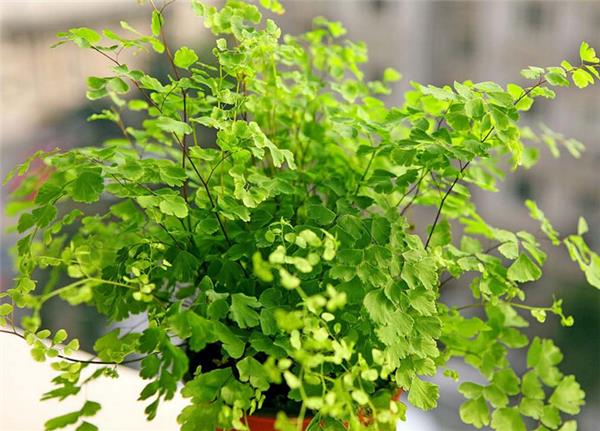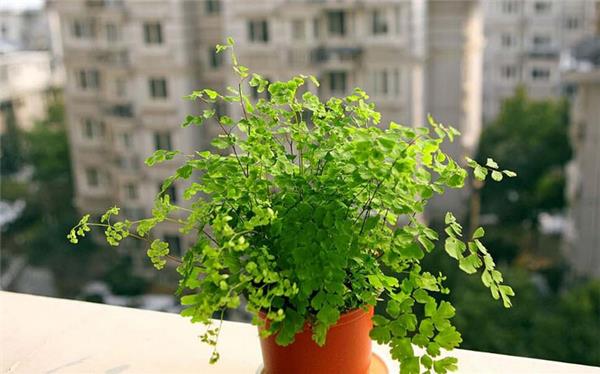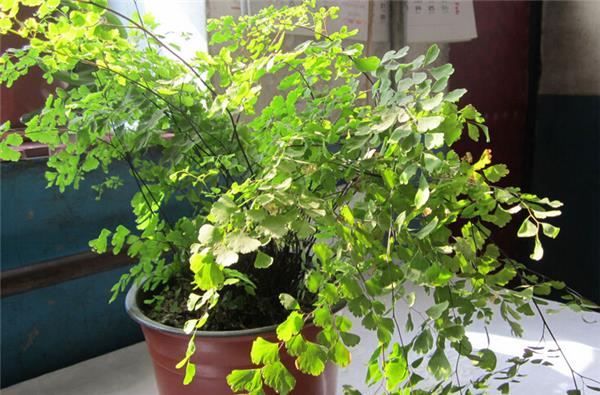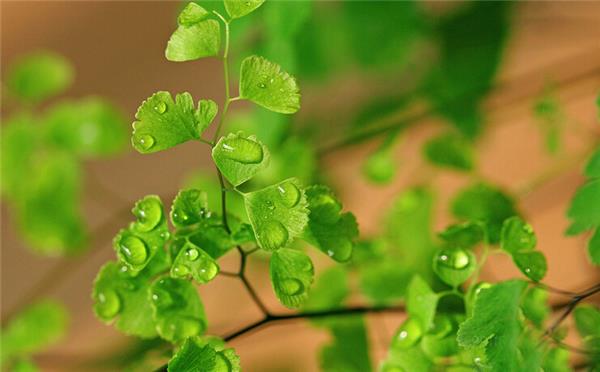How to raise iron ferns? What do you need to pay attention to?
Dryopteris prefers a warm, humid and semi-shady environment. The suitable temperature for growth is 21-25 ℃ in daytime and 12-15 ℃ at night. In winter, the leaves can keep fresh green when the temperature is above 5 ℃, but frost injury will occur when the temperature is lower than 5 ℃. Like bright scattered light, afraid of direct sunlight. Summer can be properly shaded, long-term direct light will cause most of the leaves withered and yellow. It should be placed in a brightly lit place indoors so that it can grow normally even if it is placed for 1 year. So, what is the culture method of Dryopteris?

Culture methods of Dryopteris Dryopteris
◇-- 1. Reproduction-- ◇
Under general cultivation conditions, Dryopteris fern is mainly propagated by individual plants, and it can also be propagated by robes.
Ramet propagation: usually in the spring (early and mid-April) before the new buds germinate, combined with changing pots for ramet. Knock out the plants full of pots, remove most of the old culture soil, divide them into 2 to several clumps, cut off the connected rhizomes, plant them in pots, and become new plants.
Clasping reproduction: the spores of Dryopteris fern are scattered on moist soil when they mature and can grow and develop into new plants. Therefore, it can be seen that under the flower rack at the edge of the flowerpot, there are plants that propagate and grow by themselves, which can be transplanted when they grow to a certain height.
◇-2, soil-◇
Dryopteris prefers loose, permeable and fertile calcareous sandy loam, and the cultivated soil can be mixed with loam, rotten leaf soil and river sand.
◇-3, light-◇
Like bright scattered light, afraid of direct sunlight. If the light is too strong, the leaves will be withered and yellow or even die, which can be properly shaded in summer, and most of the leaves will be withered and yellow if the strong light is directed for a long time. It should be placed in a dark place indoors, and it can grow normally even if it is placed for 1 year.

◇-4, temperature-◇
It is warm and hardy, and the suitable temperature for growth is 21-25 ℃ in daytime and 12-15 ℃ at night. In winter, the leaves can keep fresh green when the temperature is above 5 ℃, but frost injury will occur when the temperature is lower than 5 ℃.
◇-5. Watering-◇
Dryopteris likes the humid environment and should be fully watered in the peak growing season. In addition to keeping the basin soil moist, we should also pay attention to the high air humidity and sprinkle water around the plant when the air is dry. Especially in summer, water should be watered 1-2 times a day. If there is a lack of water, it will cause the leaves to shrink. Watering taboo basin soil when dry and sometimes wet, easy to make the leaves yellow.
◇-6. Fertilization-◇
Apply thin liquid fertilizer 2-3 times a month, do not stain the leaves, so as not to cause rotten leaves, because of the calcium-loving habits of Dryopteris, basin soil should add appropriate amount of lime and broken eggshell, the effect of regular application of calcium fertilizer will be better. In winter, we should reduce watering and stop fertilizing.

◇-7, insect pests-◇
Potted Dryopteris, often with leaf blight, can be controlled with Bordeaux solution at the initial stage, and 70% methyl topiramate 1000-1500 times in severe cases. If the plant is damaged by scale insects, 40% omethoate 1000 times solution can be used for control.
◇-8. Pruning-◇
After the beginning of autumn, as the temperature drops, the fern enters a slow growth stage, and the old leaves will gradually turn yellow, so they should be cut off.
◇-- 9. Change basin-- ◇
Potted Dryopteris, pot can choose light glaze basin and tile basin, basin soil must have good water permeability and ventilation, generally with humus-rich peat soil or rotten leaf soil, and then add about 1 pound 3 coarse sand and fine sand, and put in some bone powder, and the bottom of the basin should be covered with some broken tiles or coarse sand to facilitate drainage, the rhizome planting depth is 1.5 to 2.5 meters. Spring planting or turning the basin to change soil, pot planting commonly used humus soil or peat soil, plus a small amount of river sand and base fertilizer mixed culture soil. Change the box every spring, do not hurt the root when changing the basin, avoid the wind blowing, and keep the basin soil moist and high air humidity. It can be managed normally after the new branches grow.
Dryopteris likes the humid environment and should be fully watered in the peak growing season. In addition to keeping the basin soil moist, we should also pay attention to the high air humidity and sprinkle water around the plant when the air is dry. Especially in summer, water should be watered 1-2 times a day. If there is a lack of water, it will cause the leaves to shrink. Watering taboo basin soil when dry and sometimes wet, easy to make the leaves yellow. Apply dilute liquid fertilizer 2-3 times a month, do not stain the leaf surface when applying fertilizer, so as not to cause rotten leaves. Because of the calcium-loving habit of Dryopteris Dryopteris, the basin soil should add appropriate amount of lime and broken eggshell, and the effect of calcareous fertilizer will be better. In winter, we should reduce watering and stop fertilizing. What are the matters needing attention in the process of cultivating Dryopteris?

Matters needing attention in Dryopteris culture
◇-1. Although the indoor light is not too dark at ordinary times, the general indoor light is a little darker for Dryopteris, so it is best to put it in a brightly lit place.
◇-2. Dryopteris prefers a cool climate. The growth temperature is between 15 ℃ and 25 ℃. The temperature of the leaves should not be lower than 7 ℃, otherwise the leaves may be frostbitten.
◇-3. Dryopteris likes the environment with high humidity very much, so it should be watered 4 or 5 times a day in spring, summer and autumn.

◇-4. Fertilization is necessary for Dryopteris, but according to the principle of "small amount and more application", 1000-2000 times dilution such as Huabao can be used.
◇-5. Dryopteris is naturally fond of warm, humid and semi-cold environments and hates direct sunlight.
◇-6. Pteridophytes grow in humid environments, and ferns are no exception for Dryopteris.
◇-7. The pot should be changed once every spring, and the dried leaves and old roots should be trimmed at the same time.

After reading this article, I believe you must have a deeper understanding of how to raise Dryopteris and the breeding method of Dryopteris. As long as we follow scientific breeding methods and careful maintenance, we will be able to grow beautiful and colorful ferns. The above is about how to raise Dryopteris, the breeding methods of Dryopteris and matters needing attention. I hope it can be helpful to everyone.
The indoor light is not too dark, but the general indoor light is still a little darker for Dryopteris, so it is best to put it in a brightly lit place.
◇-2. Dryopteris prefers a cool climate. The growth temperature is between 15 ℃ and 25 ℃. The temperature of the leaves should not be lower than 7 ℃, otherwise the leaves may be frostbitten.
◇-3. Dryopteris likes the environment with high humidity very much, so it should be watered 4 or 5 times a day in spring, summer and autumn.

◇-4. Fertilization is necessary for Dryopteris, but according to the principle of "small amount and more application", 1000-2000 times dilution such as Huabao can be used.
◇-5. Dryopteris is naturally fond of warm, humid and semi-cold environments and hates direct sunlight.
◇-6. Pteridophytes grow in humid environments, and ferns are no exception for Dryopteris.
◇-7. The pot should be changed once every spring, and the dried leaves and old roots should be trimmed at the same time.

After reading this article, I believe you must have a deeper understanding of how to raise Dryopteris and the breeding method of Dryopteris. As long as we follow scientific breeding methods and careful maintenance, we will be able to grow beautiful and colorful ferns. The above is about how to raise Dryopteris, the breeding methods of Dryopteris and matters needing attention. I hope it can be helpful to everyone.
Related
- Wuhan Hospital Iron Tree Blooming Result Was Instantly Frightened by the Gardener Master
- Which variety of camellia is the most fragrant and best? Which one do you like best?
- What is the small blue coat, the breeding methods and matters needing attention of the succulent plant
- Dormancy time and maintenance management of succulent plants during dormancy
- Minas succulent how to raise, Minas succulent plant pictures
- What are the varieties of winter succulent plants
- How to raise succulent plants in twelve rolls? let's take a look at some experience of breeding twelve rolls.
- Attention should be paid to water control for succulent plants during dormant period (winter and summer)
- Watering experience of twelve rolls of succulent plants
- Techniques for fertilizing succulent plants. An article will let you know how to fertilize succulent plants.



